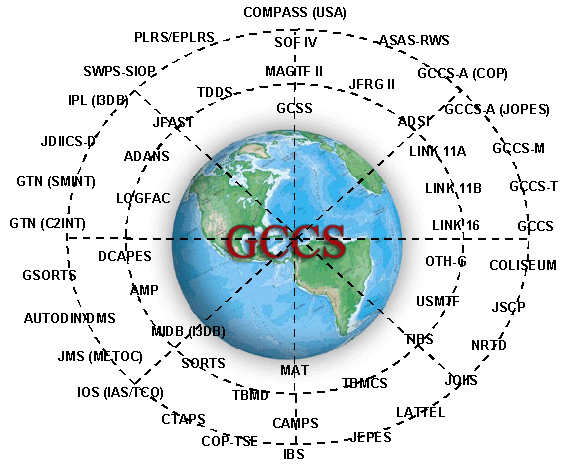





The Global Command and Control System (GCCS) is an automated information system designed to support deliberate and crisis planning with the use of an integrated set of analytic tools and the flexible data transfer capabilities. GCCS will become the single C4I system to support the warfighter from foxhole to command post.
The C4I for the Warrior (C4IFTW) concept is committed to the challenge of meeting the warrior's quest for information needed to achieve victory for any mission, at any time, and at any place. C4IFTW is the vision and roadmap for creating a broadly connected joint system providing total battlespace information to the warrior.
Joint operations involving multiple land, sea and air units in adaptive joint force structures increasingly require joint networks and joint systems that are fully interoperable horizontally across air, sea, space and ground environments. This is the ultimate goal of C4IFTW. The Global Command and Control System (GCCS) is the midterm solution and the bridge to the concepts outlined in the C4IFTW concept. GCCS is C4IFTW in action, today.

Facts/Discussion
GCCS is a common operating environment (COE), integration standard, and migration strategy that eliminates the need for inflexible stovepipe command and control systems and expensive duplication. It is the migration of existing systems into a new COE connected across the Secret Internet Protocol Router Network (SIPRNET) and the integration of selected command and control (C2) systems into a comprehensive, interoperable system.
Its first priority is to demonstrate the C4IFTW concept's vision by becoming a globally connected, warrior-involved, interoperable, fully-integrated C4 system. The GCCS core consists of the basic functions required by the warfighter to plan, execute, and manage military operations. These functions are then satisfied by selecting the applications from existing C2 systems that best meet the requirement. This ensures interoperability, minimizes training requirements and allows efficient use of limited defense resources. GCCS has been identified by the Assistant Secretary of Defense for Command, Control, Communications and Intelligence as the C2 migration system to meet the goal of migrating the many Service systems into fewer, better integrated systems.
GCCS is not a traditional acquisition program nor a grand design effort that is difficult or cumbersome. It remains simple and straightforward, being implemented one step at a time as user feedback helps build the next step. It implements a flexible and highly adaptive client-user architecture, tailored for the warfighter as specified by the warfighter.
On August 30, 1996, DISA officially pulled the plug on the Worldwide Military Command and Control System (WWMCCS) Intercomputer Network (WIN). Concurrently, the Joint Staff declared the Global Command and Control System (GCCS) as the joint command and control system of record.
The NCA implement command and control (C2) through a process that extends global influence over our national agencies, military forces, allies, and ultimately, over our adversaries. The process is extended through a system which provides NCA and subordinate leaders with a means to exercise their authority and direction. This process uses information to coordinate resources toward common mission objectives. It involves a continuous dynamic interaction between information, the organization, and a support system. Warfighting CINCs, subunified commands, CJTFs, their respective Service components, and coalition forces require the ability to respond rapidly and appropriately to contingencies.
The primary objective of GCCS is to have an architecture consisting of C2 forces and elements within a highly flexible system. It must be able to collect, process, disseminate, and protect information. It will support the NCA and subordinate elements in the generation and application of national power.
Private industry is progressing toward open systems, user friendly software, and client-server architectures. The Government must leverage its automation investments by using commercial off-the-shelf software (COTS) with appropriate security. Otherwise, it will be forced to maintain outdated systems. The objective of GCCS is to take advantage of industry de facto standards and user friendly software. The software will be portable for a wide range of system architectures.
GCCS will be an infosphere (information sphere) of software and hardware that will link systems together during operations. An infosphere consists of distributed global networks, computer hardware and software, space-based C2 support, and other related support systems.
Planning support must be available on a "push" or "pull" basis as required by the CJTF. "Push" implies over-the-air updating initiated by the source and based on predetermined criteria. "Pull" implies the provision of tailored information upon specific request. A standard interface to the theater/operational infosphere must be provided to all C4I systems. It must permit access in either the "push" or "pull" mode to multimedia information.
GCCS is a command and control system supporting the joint Chiefs of Staff (JCS) and Commanders in Chief (CINCs) in managing military assets. GCCS will support six mission areas (operations, mobilization, deployment, employment, sustainment, and intelligence) though eight functional areas:
